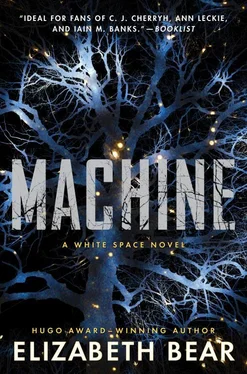Which led us to a new complex of problems. Because I had even less idea where to begin with Helen, or how to get her to let us take care of her so we could save her and her crew.
And get somebody over to the docked methane ship, too. That was a totally unaddressed problem, still hanging out there. Waiting out there.
At least it was a smaller-scale problem.
_____
“You can come with me,” I said to Helen. “That way you can be sure I don’t do anything to harm your crew.”
Helen seemed to study me—disconcerting, given her eyeless, faceless face. I could only assume that it was a behavior she’d been designed to model by the same engineer who gave her the sexualized peripheral.
“I will come with you,” she agreed, on the other side of I-didn’t-even-want-to-contemplate-how-many simulations. “You will not move my crew without my permission. And the other doctor stays here.”
Tsosie shook his head inside the hardsuit. I overruled him.
There was a mystery here, and I have never been good at letting go of mysteries. I can’t leave a crossword puzzle unfinished, and when I was in the Judiciary I never let go of a cold case.
I mean, sure, I could get the bulldog tendency corrected. But it’s part of my identity. So I pick careers where being a bulldog helps.
I wasn’t sure it was helping now. But here I was, and I wasn’t going to magically turn into someone different in time to save thousands of lives.
“I’ll agree to those conditions until further notice,” I said. “Take me to the crew.”
The gravity was getting to me. I wasn’t used to this much, for this long, with the kind of sustained physical activity we’d experienced crawling under and around the machine.
Some kind of immaterial barrier (electrostatic?) held the air inside the airlock, but let more solid objects—such as me—pass through.
When I went out into the space of the hold, the first thing that struck me was that it was not, for a wonder, full of tinkertoys. I’d become so used to picking my away around them that it felt a little strange, for the first few moments, to reach out or gesture and not see a wave of them unzipping and rezipping themselves around my hand.
The machine—or the bit of it that had come through the door with us—did follow me into the cargo hold. Maybe that was what she meant by “I will come with you.”
I’d been hoping it would be just the Helen peripheral—I was becoming more and more convinced that I was dealing with whatever remained of Big Rock Candy Mountain ’s shipmind—but her golden figure remained in the airlock beside Tsosie and waved me out among the coffins. I was escorted on my mission of mercy by a latticework tendril made of brilliantly holographic microbots. It was one of the more unsettling search-and-rescue partners I’ve ever worked with.
The machine didn’t do anything at first, however, except hover over my shoulder.
Since there was no atmosphere in the cargo hold to carry sound, I made sure my radio was transmitting unencrypted and spoke into my suit mike, “Where did the machine come from?”
Helen heard it, as I had suspected, and the question seemed to puzzle her. Her answer came back through my suit. “It… made itself?”
“It looked like you were making the component parts, when we met you.”
“I was making the spindles and connectors,” she said. “But they’re not the machine. Or they’re not all of the machine. The machine is an idea.”
I wondered. If the machine was a part of her, and she had made the machine, then it made sense to say that the machine had made itself. But her cognition on this topic, as on certain others, seemed blocked.
It was certainly possible that it was blocked. That someone, sometime, had intentionally closed those pathways and instituted a kind of machine denial in her. Human beings were perfectly capable of blatantly ignoring objective reality all on our lonesome. AIs had to be programmed to do it.
If she had been blocked, though, there was no way for me to fix it, and trying to get her to talk about it wouldn’t lead to any kind of self-realization about the conflict. Talk therapy doesn’t work on lines of code. And no matter what the three-vees say, you can’t actually send an AI into crisis and meltdown by challenging its programmed assumptions. They can grow and change—that’s one of the things that makes them sentient—but they can’t shake off a code block any more than I could regrow a severed trunk nerve.
Sally could fix it, given time. And there were code doctors at Core General that could fix it, if we could get her there.
Whatever had been done to her, though, the person who had set it up seemed to have set up defenses around it. It was becoming plausible that what had happened to Helen—and to Big Rock Candy Mountain —was an act of self-sustaining sabotage. But on the part of a member of the crew, or the crew of the docked vessel, which we hadn’t investigated yet, or something else entirely?
I picked my way along the row of cryo chambers, sighing in frustration as I examined them. They were not designed for human technicians to maintain. There were no readouts. There were no telltales or happy blinking lights. There was row upon row of… honestly, they looked more like chest freezers than like coffins. They didn’t look at all like a Synarche cryo tank, which at least partially confirmed my supposition that Helen or her crew had invented cryonic technology on the… fly, as it were. The chambers looked as if she had assembled them from whatever materials were available.
They didn’t need readouts. Nobody was ever supposed to look at them and see if they were working other than Helen and the machine.
And, well, Helen appeared to be superficially correct. Whether those cryo chambers contained living persons or dead ones, they were all intact.
The chambers did each have a battery, which made my life that much easier. I thanked Helen profusely when she mentioned them to me. We’d have to fab chargers that fit these ports when we moved the caskets, but I wasn’t too concerned about that. We had the printers, and we could copy one of the originals. Electricity is a remarkably simple—though dangerous—animal.
The number of chambers we could haul would be limited by the amount of juice we could generate more than by our cargo space.
“Helen,” I said, “can I connect to the data storage on one of these chambers to run some diagnostics?”
“I will have to print you a connector,” she said. “They don’t broadcast a signal.”
“They’re hardwired into your systems.”
I had a tickle of an idea on how to get us out of this situation. How to get control of it. I couldn’t be certain that my encryption with Sally was completely secure, and I needed her for it.
I hoped she would guess.
Helen said, “Into the machine.” She began to drift toward me, body poised and toes pointed, like a monster levitating toward its victim in some old three-vee.
“Are you part of the machine?” I asked, very casually.
Tsosie’s level of worry spiked so high that Sally bumped his antianxiety cocktail before clearing it with him. She was within her rights as a shipmind to do it—she, like Helen, had an obligation to her crew—but I picked up his irritation that she’d felt the need.
Llyn, you’re going to invite her right into your fox? That’s too risky. I cannot allow it!
Relax. Sally has my back.
I didn’t have time to say more, because Helen was answering.
“We are all,” she said, with great conviction, “part of the machine.”
It sent a chill up my spine, and I didn’t tune the unease away. A certain wariness was good. A certain wariness was my brain and body telling me that I was in a dangerous situation. A certain wariness was useful. Sensible.
Читать дальше












